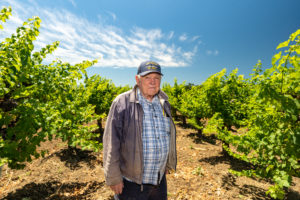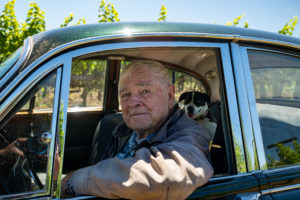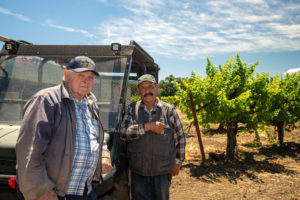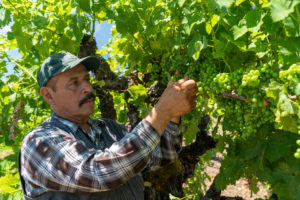Growing Together Summer 2022
‘Keep Chugging Along’: Potter Valley wine grape grower defies early critics, embodies evolution

From the Upper West Side of Manhattan, New York, to the University of Notre Dame and the U.S. Navy overseas, including the Mekong Delta during the Vietnam War. That was Guinness McFadden’s path — about as long and meandering a journey possible, literally and figuratively — to becoming one of the most innovative growers in the Potter Valley of Mendocino County. He navigated much of that journey from behind the wheel of his British racing green 1962 Jaguar Mark 2 sedan.
He’s still got that Jag that even accompanied him to Europe during his military service there. The now 60-year-old automobile serves as a reminder of the three-word mantra that’s driven his operation since the first days when he learned of vacant agricultural land in Potter Valley.
“Keep chugging along,” said McFadden, whose McFadden Family Vineyard & Farm was established humbly in 1970 and today produces unique red, rosé, sparkling and white wines. The self-professed outsider was first bitten by the agriculture bug when pursuing a graduate degree at Stanford University alongside many of his Navy veteran friends and former colleagues. The young veterans were from all over the country but shared a common mindset: none of them saw the transition from military service to corporate America to be much of a savory idea.
“After serving in the Navy for nine years, I went to Stanford Business School, so that’s what got me to California. Probably two-thirds of my class at Stanford were former Naval officers like myself, and we didn’t look too fondly on the notion of a corporate existence,” McFadden said. “Most were like me: going to business school to delay the inevitable decision we’d all have to make.”
So when the chance opportunity arose to begin what has become a multi-generational vineyard and herb farm, he jumped at it.
“One of my classmates was from Texas with an ag background. He came to school one day with a United Farm catalog and there was a place for sale in the Napa Valley for a potential vineyard,” McFadden said. “I liked the notion and went and looked at it. Then, I quit Stanford and started looking for more ground to plant vineyards.”

An ‘up-and-down adventure’ in defying critics
It was far from a storybook beginning.
“I didn’t know what I was doing. And I was the first outside guy,” McFadden said of the early days of his operation. He taught seventh and eighth grade at a local school to save money he’d later invest in establishing grapes. Other local growers had doubts. Many thought his specific location would not yield quality, high-demand wine.
“When I did start raising a crop, there weren’t a lot of people who thought the grapes would be any good,” McFadden said in recalling the early days. “Finally, once I started harvesting and delivering, people said they were pretty good.”
Undeterred by his early critics who questioned his establishing grapes in an area known to be difficult to consistently raise the crop because of frequent frost, McFadden’s first 23 acres would be the foundation for the now 160-acre vineyard (the entire farm covers more than 500 acres) that feeds Blue Quail, the label he established in 2003. Today, the range of Blue Quail wine includes Sauvignon Blanc, Chardonnay, Pinot Gris, Gewürztraminer, Riesling, Rosé, Pinot Noir and Zinfandel.
“I learned from immersion and experimenting. I developed a trellis system by modifying previous ideas. With things like that, I’ve been pointed in the right direction by others. I can’t say all ideas we’ve tried have been mine to begin with,” McFadden said. “I have done a lot of things that haven’t turned out well at all. I’ve tried a bunch of stuff because I thought it’d be worth trying. You don’t hit a home run every time you get up to bat. It’s been an up-and-down adventure.”
Though he was able to continue to grow and evolve from day-one, McFadden said it took over three decades before he looked back and thought “I’ve made it”.
“When I produced my first wine label in 2003, it was 33 years after I started this farm. I knew by then that the stuff I was growing was good,” he said. “Since then, we’ve gone on and continued to expand what we put in our own label. I think it’s shown that my initial risk was well-taken.”
A spirit of innovation and evolution
It’s his willingness to swing for the fences — occasionally driving in runs via singles or doubles when he couldn’t quite connect on a long ball — that’s characterized McFadden’s operation from the early days. When he’s seen a need to evolve, he’s evolved. And in just about every case, those evolutionary steps have involved more than what’s grown on his farm. To McFadden, the people are what makes his operation.
“One of the things I’ve done that’s been helpful is to find other things to do outside of the actual time when we are working in the vineyard. Having the same people working the soil and working the vineyard year after year is helpful, and year-round work is important to making that happen,” he said. “So, we started growing herbs thinking if this land is good for growing quality grapes, it means the same climate would produce an herb with high essential oil values, and that’s what makes a quality herb.”

McFadden’s team also grows plants and assembles them together for wreaths that are marketed at Williams Sonoma stores in the U.S. It’s another output he added in recognition of the importance of maintaining a consistent, loyal workforce. As he’s evolved his operation over the years, he’s done so with an eye on taking care of his employees, knowing their absolute essential roles to his success.
“Labor is such a critical issue here, and in recent years, there have been a lot of ups and downs,” he said. “We have a core group of 10 to 12 employees, and my farm foreman has been here for 47 years. The next guy in seniority has been here for 35 years.”
Ask McFadden his secret in managing his workforce, and he’s quick to tell you he doesn’t have one. It’s more a matter of mutual respect and the practical application of experience in working together, something he learned during his military service.
“I learned in the Navy to listen to the people who work for me. That’s how I run my farm,” McFadden said. “I may not speak to my foreman for days, yet things keep chugging along. He’s always driving around seeing what has to be done, and I rarely countermand what he says he wants people to do. When we have a problem, we look at it and fix it.”

Evolving with an eye on his natural surroundings
It was that practical approach to every part of his operation — and his appreciation for the resources at his disposal — that started McFadden on a path that’s seen him change how he produces and consumes energy in raising crops on his diversified operation. A chance recommendation by an irrigation drip system salesman in in the late-1970s led to the establishment of a hydroelectric power installation on the Russian River, which runs through McFadden’s operation.
He converted an outdated dam into a modern power-generating structure in 1980, then began adding solar panels about 20 years later. “I never bought any drip systems from him, but the next thing I know, I have a plant that utilized a six-foot fall in the river with a dam upstream from it. Now, we have a 16-foot fall and produce power for our house,” McFadden said. “I became intrigued with solar and about 25 years ago, we put in a bunch of solar panels.”
Though still “on the grid,” he said between the solar and hydroelectric installations, the operation is essentially self-sustaining on energy. In fact, the 300 solar panels and dam generate enough power for 100 other area homes.
Why evolve and change?
It’s a question many growers may ask themselves when facing challenges that require major change. For McFadden, it’s been simple. Change isn’t always easy, but the willingness and ability to evolve have been fundamental to his operation ever since he first steered his Jaguar Mark 2 westward.
“I’m not into giving advice because I’m not qualified to do that. Ever since the first couple of chances I took, I have tried to always evolve in ways that if everything falls apart, it’s not going to be a terminal blow to the farm,” he said. “Early on, I didn’t have much to lose anyway, so I wasn’t very cautious. I’ve tried to be a little more conservative and deliberate as I go along and consider ways to evolve this operation. Just do what you think is right and do it as well as you can. Keep your eye on the marketplaces for what you want to grow, watch your costs and go from there.
